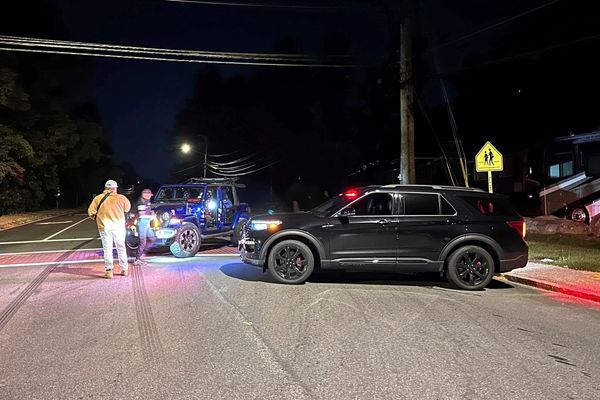
On 10 June, 1944, a troop of Waffen-SS slaughtered 643 inhabitants of the village of Oradour-sur-Glane in south-west France, before setting it ablaze to erase all trace. An exhibit of victims' family heirlooms at once shows the extent of France's biggest WWII civilian massacre and breathes life into those who perished.
Since the death of the last survivor Robert Hébras last year, there are no more eyewitnesses to recount the tragedy of the Oradour massacre. But the objects on show at the village's Memorial Centre each have their own story to tell.
Penknives, clocks stopped in time, scorched documents, melted glass, a pram riddled with bullet holes – the 200 objects bear witness to the blaze and machine-gun fire that rained down on the "martyred village" when Nazis troops set out to wipe it from the map and send a message of terror four days after the D-Day landings.
Collected in the aftermath of the massacre, most of the objects were placed in the village memorial. Others remained in victims' families and have been loaned for the temporary exhibition “Oradour, objets en héritage” (Oradour, Heirlooms).
"We know where some of the rare objects came from," says the centre's director Babeth Robert, pointing to a handbag and purse donated to the centre by the owner's daughter. "But most objects are anonymous and it's interesting to show that.
"Of the 643 victims, only 52 bodies were ever identified."
Some pieces testify to Oradour's bustling commercial activity – a thimble and pair of scissors probably belonged to one of the village tailors, while a razor and curling tongs likely came from the hairdressers.
There's little doubt that the remnants of wind instruments belonged to the village's popular l'Avenir Musical orchestra that accompanied so many festive gatherings.

Mass murders
A display of penknives shows both the ordinariness of daily life in the 1940s, and the drama of death.
"The repetition of the penknives evokes mass murders – they were found in places where the men were executed," Robert explains. "When you look at these penknives, your thoughts turn to the bodies of the men lined up in barns at the time of their execution."
The fact they would have been kept in mens' pockets and regularly held makes them particularly poignant, the historian notes.

Another display case contains dozens of mainly pocket watches.
While they're in varying states of preservation, the ones that still have their faces and hands provide information on the massacre itself.
"They've often stopped at the same time, the time of the massacre took place, in the afternoon of 10 June," says Robert. "We can well imagine that the fire was what stopped them."
Fragments of life
For some families, the heirlooms are too precious to hand over, even on loan.
The late André Desourteaux lost 19 members of his family in the massacre and returned home in the early hours of the morning of 11 June to find it destroyed. The house key, however, was still in its usual hiding place in one of the remaining walls.
A photograph of the key is shown next to the text: "The key was there, but no longer a door."
Some families have hung on to far less personal items, such as the charred fragments of the Oradour's church bell. Several pieces are on display.
"One has been kept on a stand, this one is in a kind of casket as if it were a jewel," Robert says.
A handwritten note accompanies the smallest fragment.
"Papa had always kept this piece of bell. It used to be twice the size. When he died, the souvenir was cut in two. Here is part of it," it reads.

"It's as if the most precious part of the family heritage was a fragment of bell," Robert notes. "You can’t do anything with it, but for the family it had huge importance."
Proof of mass murder
One room in the exhibition space is devoted to objects that testify to the violence of the massacre itself.
Glass bottles that have melded one into another to form an eerie modern sculpture, or metal forks that have fused together – both show the violence meted out by the extreme temperatures of the blaze.

One of the most emblematic objects is a rusty metal pram. "It was found in the church, the place where more than 450 women and children were executed," Robert says.
"The pram is riddled with bullet holes. It shows that women and children were shot dead and that the SS didn’t spare anyone, not even a baby."

The pram was used as evidence at the 1954 military tribunal in Bordeaux that tried 23 former SS men for their participation in the Oradour massacre.
Nine were German and 14 from Alsace, the French border region claimed at the time by Germany. One of each was handed a death sentence, while the others received between five and 12 years' hard labour.
The Alsaciens were later amnestied in the interests of "national cohesion".
Childless hamlets
A section devoted to childrens’ objects – balls, marbles, a spinning top, games – invites reflection on the 207 child victims, aged between one month and 14 years old.
According to a 1936 census, the population of Oradour-sur-Glane was 1,574. If "only" 673 died it's because others were working elsewhere on the day or lived in the many surrounding hamlets that lay outside the perimeter designated by the SS.
But the children from those hamlets attended the village school. They were all rounded up in the church and slaughtered.
In the memorial centre, Robert points to a display of toys, undamaged by the fire.

"They all belonged to the same boy, from Paris," she says. "His mother had sent him to live with his grandmother in one of the hamlets, to a place of safety."
Only his toys were saved.







